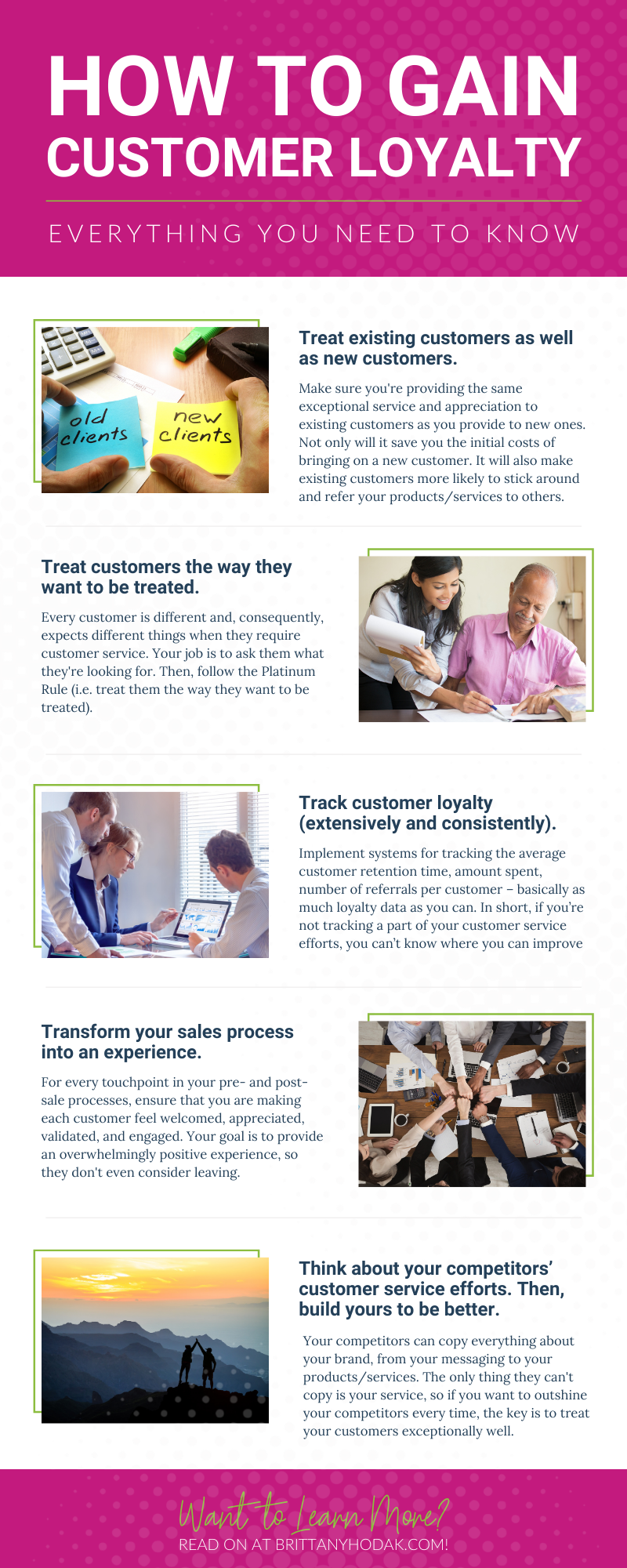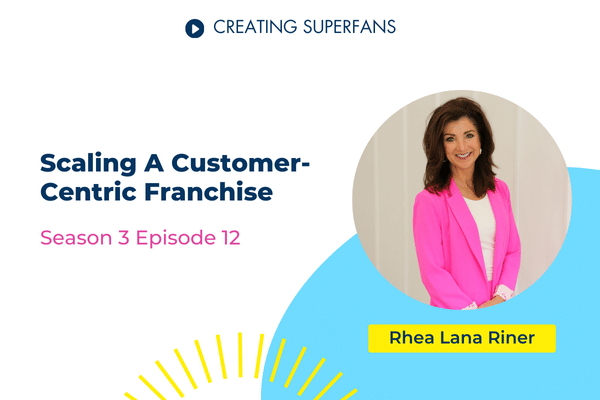When it comes to growing a business, there are a seemingly endless number of recommendations. Some say, “Focus on customer service” while others say “Inbound leads are most important” or “Work on generating more referrals.” However, underlying all of these suggestions is the same objective: building a customer base that is satisfied, loyal, and eager to share their positive experience with other potential customers. Here, we’ll focus on the second of these goals to answer the age-old question of how to gain customer loyalty.
Before we begin, it’s important to note that customer loyalty isn’t simply a goal that appears post-sale. Learning how to gain customer loyalty is a never-ending process of iteration, based on feedback from customers and insights from your sales metrics. Consequently, when you’ve made it through this blog, the next step is looking at your existing sales and service processes with a critical eye. That way, you can ask yourself, “How am I encouraging customer loyalty throughout my customers’ experience, and how can I do better?”
At the end, I’ll share a few resources to help you tackle this question with confidence. For now, let’s jump into the four steps I mentioned, so you can get started! 🎉
Treat existing customers as well as new customers.
First and foremost, learning how to gain customer loyalty starts with how you treat your customers. For many companies, the impulse is to treat new or potential new customers exceptionally well so they are encouraged to make a purchase. But, while this can initially bring in new business, it can also make existing customers feel ignored or unappreciated.

For example, in B2B sales, many advertising agencies devote a ton of energy to pitching potential clients. Then, once the deal is done, the client’s account is handed off to someone else entirely. This gives the new client the impression that they’re no longer worth the initial sales rep’s time, and it slows down their project. Likewise, in B2C sales, many cable or cell phone companies hook consumers with an amazing sign-on offer or “new client” discount. Then, after the original offer expires, the true cost of the service is much higher and the customer is left feeling unappreciated or misled.
These examples don’t mean that all advertisers or all cable companies treat new customers misleadingly well. However, they offer two important lessons. First, consider retiring any onboarding offers. If your product or service is good enough, you should be able to compete for — and win! — new customers based on the quality alone. Spend your time building and delivering a great product, and you won’t need gimmicks or short-term offers to attract new customers.
Second, treat existing customers as well as new customers. It’s anywhere from 5 to 25 times more expensive to acquire a new customer than it is to keep a current one, so treating existing customers well not only means more revenue from their future purchases. It also means money saved, as you don’t have to spend anything on onboarding new clients.
Treat customers the way they want to be treated.
Speaking of treating customers well, the second step in how to gain customer loyalty is following the Platinum Rule. Coined by Tony Alessandra and Michael J. O’Connor in their 1998 book, this rule dictates that rather than follow the Golden Rule – Treat others the way you want to be treated – the best businesses treat customers the way they want to be treated.

One past example of this is the clothing retailer ModCloth. In late 2015, after years of customer feedback, ModCloth founder Susan Gregg Koger announced they were desegregating their clothing sizes (i.e. listing items based on attributes other than size, such as style or color). When asked about this decision, Koger replied:
“I think there is still an outdated notion in the [fashion] industry that ‘plus’ should be separate because it’s less aspirational, or because that consumer is less fashion-forward, or less willing to spend on herself. But what we’re hearing and seeing from our community is that it is simply not true.”
Koger went on to explain that the common practice of excluding plus size clothing options was exactly the way customers didn’t want to be treated. In fact, considering the average American female – ModCloth’s largest audience – is a size 16-18, it wasn’t just insulting to tons of potential and existing customers. It also created a poor shopping experience for the average customer, as finding appropriately sized clothing took multiple clicks.
In the same way, treating your customers the way they want to be treated demonstrates that you (a) want them to stick around and (b) will work for their support. You don’t just expect them to buy from you. You want to hear from them and, in doing so, provide more value every time they come in contact with your brand.
Track customer loyalty (extensively and consistently).
The third step in how to gain customer loyalty is a simple one: track it extensively and consistently. Like a basic science experiment, implementing changes in your business comes in three phases. First is evaluating what you have to see where you can make changes. Second is enacting those changes, and third is recording the results. However, like a science experiment, adjusting your business processes successfully also requires analysis. That’s where customer loyalty data comes in.

Generally speaking, you can track customer loyalty through qualitative and quantitative systems. The former, qualitative tracking, is loosely defined and focuses on asking customers about their experience. This can be as simple as a phone conversation and is especially useful when you’re looking for details about a customer’s experience or a longer explanation of their thoughts around your brand.
On the other hand, quantitative data is much more numerical and focuses on rating customers’ experiences. Think surveys or pop-ups that ask “How would you rate your shopping experience?” or “How likely are you to recommend this brand to someone else?” Here, the goal is to collect numerical answers to basic questions about the customer experience, so you can better understand where the average customer experience can be improved. Below are a few numbers to begin tracking, if you haven’t already.
- Average customer retention time
- Average customer lifetime value
- Number of referring customers relative to total customers
- Your Net Promoter Score (NPS)
Ultimately, building customer loyalty means using both qualitative and quantitative methods to track it. If you’re not tracking it, you can’t know where you can improve, and if you never improve your sales and service processes, your customer base will never consistently grow. It’s as simple as that.
Transform your sales process into an experience.
That said, although loyalty metrics are valuable, it’s also helpful to look at how to gain customer loyalty from a bird’s eye view. Instead of solely looking at the numbers, remember that, for your customers, your sales process is an experience. They’re not simply looking at your products or services. They’re also asking “How does this brand make me feel?” and choosing to make a purchase based on the answer.

Recently, I remembered my own customer experience when I decided to buy a telescope last year and landed on the website for High Point Scientific. There, I immediately noticed messages like “We Want Your Business!” and “We’re Here To Help!” Additionally, I was able to talk to a real person who not only addressed my questions and concerns but also gave me his direct phone number at High Point, in case I had setup questions later on. From start to finish, I felt valued and supported, turning me from a potential customer into a happy lifetime customer — which is important since, as I’m now discovering, a backyard astronomer’s setup is never “compete!” There’s always some new lens or gadget or camera setup to buy, which is why creating customers for life is such a smart strategy.
There’s a very high chance that your business model is similar, where the first purchase isn’t the last. Therefore, if you want your own customers to turn into lifelong fans, their entire experience should make them feel valued. In my Superfan W.A.V.E. system, I outline this in detail, including specific steps you can take to make your customers feel welcomed, appreciated, validated, and engaged at every step in your sales process. Sign up for my free, five-day video course to learn more. 😊
Think about your competitors’ customer service efforts. Then, build yours to be better.

Finally, if you want to learn how to gain customer loyalty, the last place you should look is your competition. To start, look at their customer reviews, their website, and their marketing or sales efforts. Then, make note of things they are doing well and things they are doing poorly. Maybe they’re alienating a customer segment or their message is unclear. Maybe their support team is slow to respond or treats customers like numbers rather than people. Either way, even if they’re a steep competitor, every one of their customer service mistakes is a chance for your brand to shine by comparison.
Don’t skimp on this step. Secret-shop your competitors. You should be as familiar with their products and services as you are with your own. There’s a reason the most successful sports teams spend so much time studying tapes of their opponents. Put in the time to make sure you’re always, always out-performing — and out caring — your competition.

There isn’t much that’s “uncopyable” these days, from a brand’s colors to its products. The only thing that can’t be copied is a brand’s service (at least not without a LOT of effort).
In light of that, if you want to ensure your customers are loyal, focus on the underlying aspect of each of these steps: exceptional service for each and every customer. Not only will it mean more positive attention and reviews for your business. It will also turn your existing customers into evangelists for your brand. That way, instead of stressing out about your competition, you can sit back and let the referrals roll in from the customers you already have.






